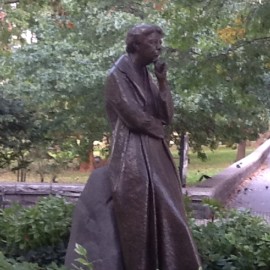Upper body posture is one of the most common problem areas in people. We’ve all had our mothers tell us to sit up straight, haven’t we? But, if we really want to stand up straight, we have to be able to get the structures in our anatomy to cooperate, such as the sternoclavicular joint.
For nice tall posture we need to be able to get our shoulder blades into a neutral position. For a more detailed explanation have a look at Retraction/Protraction/Depression/Elevation, but put briefly, neutral is having your shoulder blades more or less centered on either side of your spine. Most people’s shoulder blades are pulled out towards the side of the body (protracted). To stand up straight you need to squeeze them together towards the spine, bringing your shoulders back with it.
What I’d like to talk about today is how pulling the shoulder blades back towards the spine acts on the front of your body as well, giving you that nice, tall, head up, chest out position that your mother wants to see. Your collar bones meet on the front of your body at the sternum and they form a joint there called the sternoclavicular joint. Did you know it was there and that it moves?! If you put your fingers on the ends of your collar bone next to that little U shaped indent at the top of your sternum and shrug your shoulders up, down, forward, back and so on you will actually feel it. This movement is important for your posture and for training to improve posture.
WHAT THIS MEANS FOR YOUR EXERCISE
If you are working on your back with things like rows, pull downs, or reverse flies (which you should be) you need to pay attention to what is happening at the front of your body just as much as you pay attention to the back. When you row or perform reverse flies your shoulder blades should retract and the front of your chest should open up thanks to that helpful joint at your sternum. You should not be sinking your chest inward – something that I see happen very often at the end range of rows and pull downs. Also, make sure that the range of motion is coming from the sternum area and not from your bottom ribs. If you find that your chest tucks inward or your bottom ribs are flaring out at the end of your pull, this is a compensation pattern that we don’t want to see. You may need to lighten the load or do some mobility work or corrective exercises before continuing.
I hope that little tip gives you something new to check out during your next workout!
RELATED:
Retraction, Protraction, Elevation, Depression, and Scapulohumeral Rhythm
Rows – Three Mistakes To Avoid
P.S. – Whenever I write something like this I am reminded that it is exceedingly difficult to explain these kinds of things without being able to show someone directly. So as always, I would like to recommend that you let a fitness professional show you what this is all about.

Pingback: Rows - Three Mistakes To Avoid - do the movementdo the movement January 5, 2015
[…] up and outward in order to allow for the proper row. You can read more about that in my article on the Sternoclavicular Joint. Make sure to keep the head back as pictured […]
Pingback: Rows - Three Mistakes To Avoid - do the movement October 9, 2015
[…] at the chest, which needs to lift up and outward in order to allow for the proper row. (See The Sternoclavicular Joint) Make sure to keep the head back as pictured […]